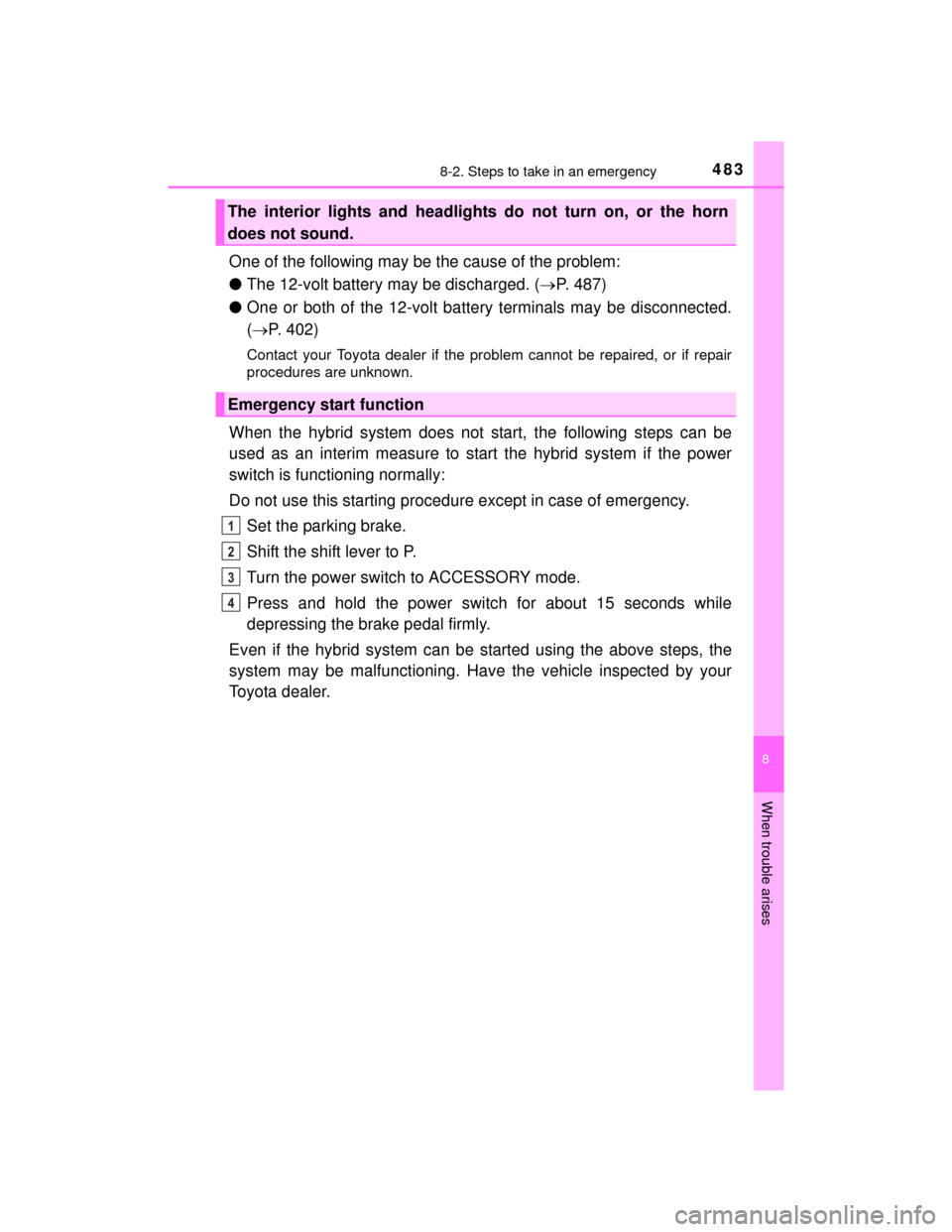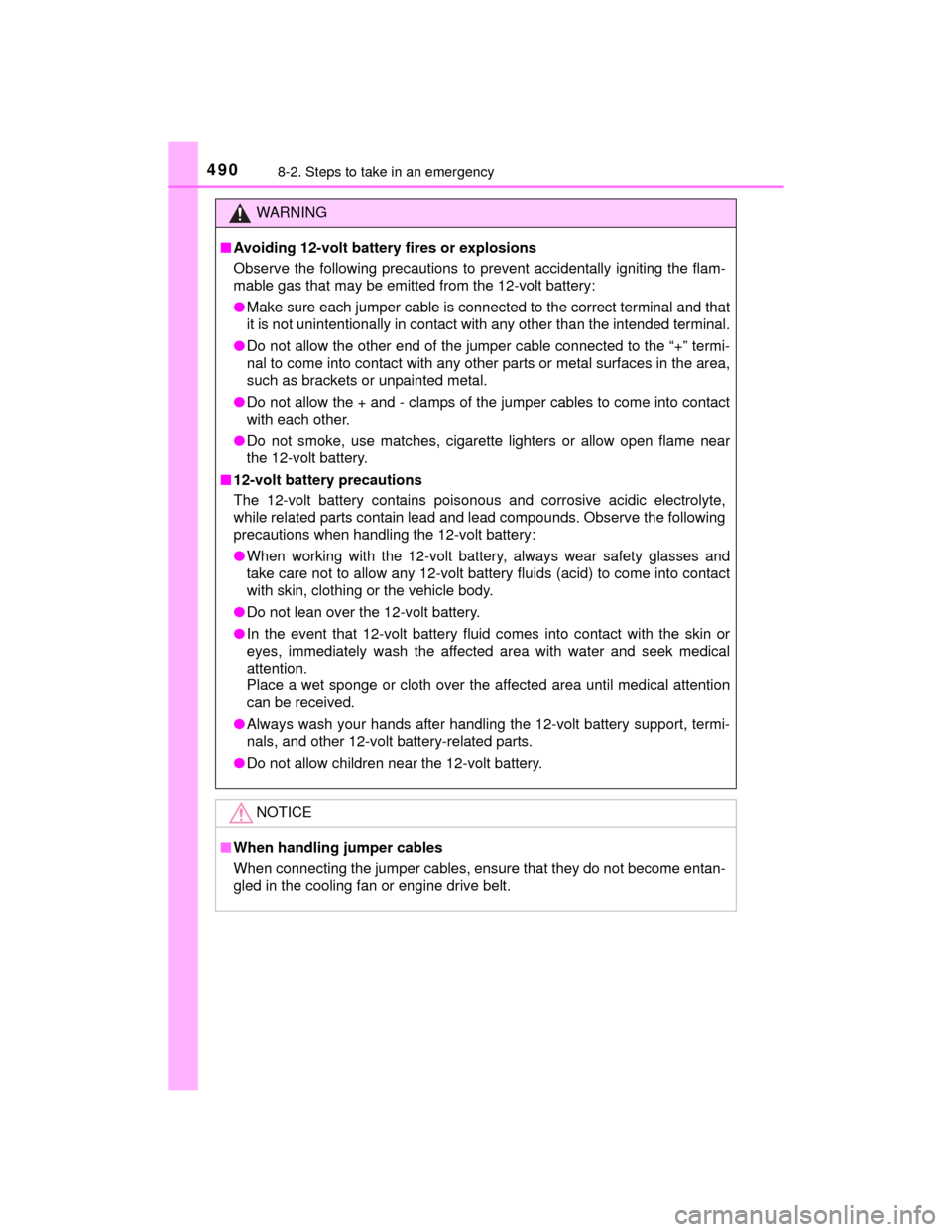Page 479 of 564

4798-2. Steps to take in an emergency
8
When trouble arises
CAMRY_HV_U (OM33A87U)
Firmly tighten each wheel nut
two or three times in the order
shown in the illustration.
Tightening torque:
76 ft•lbf (103 N•m, 10.5 kgf•m)
Stow the flat tire, tire jack and all tools.
■The compact spare tire
●The compact spare tire is identified by the label “TEMPORARY USE
ONLY” on the tire sidewall.
Use the compact spare tire temporarily, and only in an emergency.
●Make sure to check the tire inflation pressure of the compact spare tire.
( P. 505)
■When using the compact spare tire (vehicles with a tire pressure
warning system)
As the compact spare tire is not equipped with a tire pressure warning
valve and transmitter, low inflation pressure of the spare tire will not be
indicated by the tire pressure warning system. Also, if you replace the
compact spare tire after the tire pressure warning light comes on, the light
remains on.
■If you have a flat front tire on a road covered with snow or ice
Install the compact spare tire on one of the rear wheels of the vehicle.
Perform the following steps and fit tire chains to the front tires:
Replace a rear tire with the compact spare tire.
Replace the flat front tire with the tire removed from the rear of the vehi-
cle.
Fit tire chains to the front tires.
4
5
1
2
3
Page 482 of 564

4828-2. Steps to take in an emergency
CAMRY_HV_U (OM33A87U)
One of the following may be the cause of the problem:
●The electronic key may not be functioning properly. ( P. 486)
● There may not be sufficient fuel in the vehicle’s tank.
Refuel the vehicle.
● There may be a malfunction in the immobilizer system.
( P. 7 8 )
● There may be a malfunction in the steering lock system.
● The hybrid system may be malfunctioning due to an electrical prob-
lem such as an open circuit or a blown fuse. However, depending
on the type of malfunction, an interim measure is available to start
the hybrid system. ( P. 483)
One of the following may be the cause of the problem:
● The 12-volt battery may be discharged. ( P. 487)
● The 12-volt battery terminal connections may be loose or corroded.
( P. 402)
If the hybrid system will not star t
Reasons for the hybrid system not starting vary depending on
the situation. Check the following and perform the appropriate
procedure:
The hybrid system will not start even though the correct starting
procedure is being followed. ( P. 161)
The interior lights and headlights are dim, or the horn does not
sound or sounds at a low volume.
Page 483 of 564

4838-2. Steps to take in an emergency
8
When trouble arises
CAMRY_HV_U (OM33A87U)
One of the following may be the cause of the problem:
●The 12-volt battery may be discharged. ( P. 487)
● One or both of the 12-volt battery terminals may be disconnected.
( P. 402)
Contact your Toyota dealer if the problem cannot be repaired, or if repair
procedures are unknown.
When the hybrid system does not start, the following steps can be
used as an interim measure to start the hybrid system if the power
switch is functioning normally:
Do not use this starting procedure except in case of emergency.
Set the parking brake.
Shift the shift lever to P.
Turn the power switch to ACCESSORY mode.
Press and hold the power switch for about 15 seconds while
depressing the brake pedal firmly.
Even if the hybrid system can be started using the above steps, the
system may be malfunctioning. Have the vehicle inspected by your
Toyota dealer.
The interior lights and headlights do not turn on, or the horn
does not sound.
Emergency start function
1
2
3
4
Page 488 of 564
4888-2. Steps to take in an emergency
CAMRY_HV_U (OM33A87U)
Start the engine of the second vehicle. Increase the engine speed
slightly and maintain at that level for approximately 5 minutes to
recharge the 12-volt battery of your vehicle.
Open and close any of the doors of your vehicle with the power
switch off.
Maintain the engine speed of the second vehicle and turn the power
switch to ON mode, then start the vehicle's engine.
Make sure the “READY” indicator comes on. If the indicator does
not come on, contact your Toyota dealer.
Once the hybrid system has started, remove the jumper cables in
the exact reverse order from which they were connected.
Once the hybrid system starts, have the vehicle inspected at your
Toyota dealer as soon as possible.3
4
5
6
7
Page 489 of 564

4898-2. Steps to take in an emergency
8
When trouble arises
CAMRY_HV_U (OM33A87U)
■Starting the hybrid system when the 12-volt battery is discharged
The hybrid system cannot be started by push-starting.
■ To prevent 12-volt battery discharge
●Turn off the headlights and the audio system while the hybrid system is off.
● Turn off any unnecessary electrical components when the vehicle is running
at a low speed for an extended period, such as in heavy traffic.
■ Charging the 12-volt battery
The electricity stored in the 12-volt battery will discharge gradually even when
the vehicle is not in use, due to natural discharge and the draining effects of
certain electrical appliances. If the vehicle is left for a long time, the 12-volt
battery may discharge, and the hybrid system may be unable to start. (The
12-volt battery recharges automatically during driving.)
■ When recharging or replacing the 12-volt battery
●In some cases, it may not be possible to unlock the doors using the smart
key system when the 12-volt battery is discharged. Use the wireless remote
control or the mechanical key to lock or unlock the doors.
● The hybrid system may not start on the first attempt after the 12-volt battery
has recharged but will start normally after the second attempt. This is not a
malfunction.
● The power switch mode is memorized by the vehicle. When the 12-volt bat-
tery is reconnected, the system will return to the mode it was in before the
12-volt battery was discharged. Before disconnecting the 12-volt battery,
turn the power switch off.
If you are unsure what mode the power switch was in before the 12-volt bat-
tery discharged, be especially careful when reconnecting the 12-volt battery.
● Vehicles with an alarm: Make sure that the key is not inside the vehicle
when recharging or replacing the 12-volt battery. The key may be locked in
the vehicle if the alarm is activated. ( P. 81)
Page 490 of 564

4908-2. Steps to take in an emergency
CAMRY_HV_U (OM33A87U)
WARNING
■Avoiding 12-volt battery fires or explosions
Observe the following precautions to prevent accidentally igniting the flam-
mable gas that may be emitted from the 12-volt battery:
●Make sure each jumper cable is connected to the correct terminal and that
it is not unintentionally in contact with any other than the intended terminal.
● Do not allow the other end of the jumper cable connected to the “+” termi-
nal to come into contact with any other parts or metal surfaces in the area,
such as brackets or unpainted metal.
● Do not allow the + and - clamps of the jumper cables to come into contact
with each other.
● Do not smoke, use matches, cigarette lighters or allow open flame near
the 12-volt battery.
■ 12-volt battery precautions
The 12-volt battery contains poisonous and corrosive acidic electrolyte,
while related parts contain lead and lead compounds. Observe the following
precautions when handling the 12-volt battery:
●When working with the 12-volt battery, always wear safety glasses and
take care not to allow any 12-volt battery fluids (acid) to come into contact
with skin, clothing or the vehicle body.
● Do not lean over the 12-volt battery.
● In the event that 12-volt battery fluid comes into contact with the skin or
eyes, immediately wash the affected area with water and seek medical
attention.
Place a wet sponge or cloth over the affected area until medical attention
can be received.
● Always wash your hands after handling the 12-volt battery support, termi-
nals, and other 12-volt battery-related parts.
● Do not allow children near the 12-volt battery.
NOTICE
■When handling jumper cables
When connecting the jumper cables, ensure that they do not become entan-
gled in the cooling fan or engine drive belt.
Page 504 of 564

5049-1. Specifications
CAMRY_HV_U (OM33A87U)
*: The fluid capacity is a reference quantity. If replacement is necessary, con-tact your Toyota dealer.
*1: Minimum pedal clearance when depressed with a force of 112 lbf (500 N,51 kgf) while the hybrid system is operating
*2: Parking brake pedal travel when depressed with a force of 67 lbf (300 N,31 kgf).
Electrical system
12-volt battery
Open voltage at
68 F (20 C):
12.6 12.8 V Fully charged
12.2 12.4 V Half charged
11 . 8 12.0 V Discharged
(Voltage checked 20 minutes after the hybrid
system and all the lights turned off)
Charging rates5 A max.
Transmission
Fluid capacity*3.9 qt. (3.7 L, 3.3 Imp. qt.)
Fluid type Toyota Genuine ATF WS
NOTICE
■Transmission fluid type
Using transmission fluid other than “Toyota Genuine ATF WS” may ulti-
mately damage the transmission of your vehicle.
Brakes
Pedal clearance*13.62 in. (92 mm)
Pedal free play 0.04 0.24 in. (1 6 mm)
Brake pad wear limit0.04 in. (1.0 mm)
Parking brake lining wear limit0.04 in. (1.0 mm)
Parking brake pedal travel*27 10 clicks
Fluid type SAE J1703 or FMVSS No.116 DOT 3
Page 506 of 564
5069-1. Specifications
CAMRY_HV_U (OM33A87U)
*1: Light bulbs not listed in this table are LED bulbs.
*2: If equipped
Light bulbs*1
Light bulbsBulb No.WTyp e
ExteriorHeadlights
Low beam
*2
High beam
*2
9005 55
60A
B
Front side marker
lights W5W 5 C
Front turn signal/
parking lights
(bulb type)
*27444NA 28/8 D
Rear turn signal lights WY21W 21 D
Stop/tail/rear side
maker lights 7443 21/5 C
License plate lights W5W 5 C
Back-up lights 921 16 C
Interior Front interior/per-
sonal lights
*2
5C
Rear interior/personal
lights
*2 8C
Interior light
*2 8E
Door courtesy lights 168 5 C
Vanity lights
*2 8C
Trunk light 194 3.8 C
A: H11 halogen bulbs
C: Wedge base bulbs (clear) E: Double end bulbs B: HB3 halogen bulbs
D: Wedge base bulbs (amber)